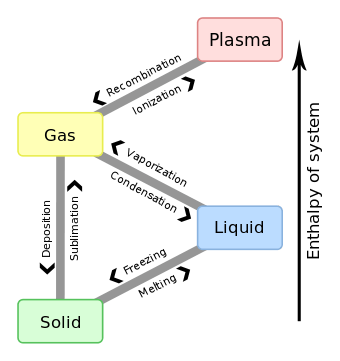Superheating
- This article is about the phenomenon where a liquid can exist in a metastable state above its boiling point. See superheated water for pressurized water above 100 °C. See superheater for the device used in steam engines.
In physics, superheating (sometimes referred to as boiling retardation, or boiling delay) is the phenomenon in which a liquid is heated to a temperature higher than its boiling point, without boiling. Superheating is achieved by heating a homogeneous substance in a clean container, free of nucleation sites, while taking care not to disturb the liquid.
Cause

Water is said to "boil" when bubbles of water vapor grow without bound, bursting at the surface. For a vapor bubble to expand, the temperature must be high enough that the vapor pressure exceeds the ambient pressure (the atmospheric pressure, primarily). Below that temperature, a water vapor bubble will shrink and vanish.
Superheating is an exception to this simple rule; a liquid is sometimes observed not to boil even though its vapor pressure does exceed the ambient pressure. The cause is an additional force, the surface tension, which suppresses the growth of bubbles.[1]
Surface tension makes the bubble act like a rubber balloon (more precisely, one that is under-inflated so that the rubber is still elastic). The pressure inside is raised slightly by the "skin" attempting to contract. For the bubble to expand, the temperature must be raised slightly above the boiling point to generate enough vapor pressure to overcome both surface tension and ambient pressure.
What makes superheating so explosive is that a larger bubble is easier to inflate than a small one; just as when blowing up a balloon, the hardest part is getting started. It turns out the excess pressure due to surface tension is inversely proportional to the diameter of the bubble.[2] This means if the largest bubbles in a container are only a few micrometres in diameter, overcoming the surface tension may require exceeding the boiling point by several degrees Celsius. Once a bubble does begin to grow, the pressure due to the surface tension reduces, so it expands explosively. In practice, most containers have scratches or other imperfections which trap pockets of air that provide starting bubbles. But a container of liquid with only microscopic bubbles can superheat dramatically.
Occurrence via microwave oven
Superheating can occur when an undisturbed container of water is heated in a microwave oven. When the container is removed, the water still appears to be below the boiling point. However, once the water is disturbed, some of it violently flashes to steam, potentially spraying boiling water out of the container.[3] The boiling can be triggered by jostling the cup, inserting a stirring device, or adding a substance like instant coffee or sugar. The chances of superheating are greater with smooth containers, because scratches or chips can house small pockets of air, which serve as nucleation points. Chances of superheating can increase with repeated heating and cooling cycles of an undisturbed container, like when a forgotten coffee cup is re-heated without being removed from a microwave oven. This is due to heating cycles progressively de-gassing the liquid. There are ways to prevent superheating in a microwave oven, such as putting a popsicle stick in the glass or using a scratched container.
Applications
Superheated hydrogen liquid is used in bubble chambers.
Myth
There is a common belief that superheating can occur only in pure substances. This is untrue, as superheating has been observed in coffee and other impure liquids. Impurities do prevent superheating if they introduce nucleation sites (rough areas where gas is trapped); for example, sand tends to suppress superheating in water. Dissolved gas can also provide nucleation sites when it comes out of solution and forms bubbles. However, an impurity such as salt or sugar, dissolved in water to form a homogeneous solution, does not prevent superheating. Other liquids are known to superheat including 2% milk and almond milk.[4]
See also
References
- ↑ Critical Droplets and Nucleation, Cornell Solid State Lab
- ↑ Atmosphere-ocean Interaction By Eric Bradshaw Kraus, Joost A. Businger Published by Oxford University Press US, 1994 ISBN 0-19-506618-9, pg 60.
- ↑ Urban Legends Reference Pages: Superheated Microwaved Water
- ↑ Beaty, William & U. Washington. "Impure water can also undergo superheating. Any superheated liquid can be dangerous so when superheating exercise caution". Retrieved 2007-11-24.
External links
- Video of superheated water in a microwave explosively flash boiling, why it happens, and why it's dangerous.
- Bloomfield, Louis A. "A series of superheated water with oil film experiments done in the microwave by Louis A. Bloomfield, physics professor at the University of Virginia. Experiment #13 proceeds with surprising violence". Archived from the original on 2 June 2008.
- Video of superheated water in a pot.
